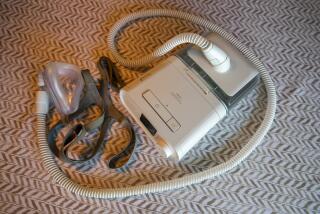FDA Will Decide on Safety of Saline-Filled Breast Implants
- Share via
WASHINGTON — The Food and Drug Administration will open an inquiry today into the safety of saline-filled breast implants--the only breast implant still generally available--and ultimately will decide whether they are safe enough to remain on the market.
Part of the deliberations almost certainly will revolve around the delicate issues of risks compared to benefits--an equation that changes dramatically when debating cosmetic enlargement versus reconstruction after mastectomy.
The investigation comes eight years after the agency tightly restricted the use of silicone gel implants in the aftermath of an intense and emotional national debate about the devices. Many women blamed the silicone devices for a range of harmful health consequences, including autoimmune diseases and other conditions, although a scientific link has not been proved.
Nevertheless, the controversy provoked extensive and complicated litigation--driving at least one manufacturer into bankruptcy--and resulted in the FDA’s removing the implants from the market for nearly all cosmetic purposes. They are now allowed only for medical necessity, such as reconstruction after breast surgery or to correct deformities.
The latest review is part of the FDA’s continuing study of medical devices that went on the market before 1976, when Congress gave the agency the authority to regulate them. An advisory committee of outside experts will listen to testimony and other data for three days.
At the end of the hearing, panel members will vote on whether the saline devices are safe enough to remain available and make a recommendation to the full agency. Although the recommendations are not binding, they typically wield considerable influence in agency decision-making.
Saline implants have been regarded as safer than their silicone counterparts, although they are not considered problem-free. There have been reports of infection, bacterial contamination, rupture or deflation, hardening of scar tissue, distortion and shifting of the implant, skin rashes and loss of nipple sensation. The devices, while filled with salt water, are encased in a sheath made of a silicone material.
Regardless of the complications, their popularity apparently has not dimmed in recent years.
Although sales of saline devices slipped during the years silicone devices were available, they increased after silicone implants were taken off the market. In 1998, the most recent year numbers were available, about 130,000 saline implants were sold in the United States.
“Our hope is that someday women have access to a safe product,” said Sybil Nidel Goldrich, executive director of Command Trust Network, a women’s support group. “In the meantime, we urge the FDA to insist that women be given a full set of facts about implants . . . before they put their health at risk.”
At the hearing, Dr. Scott Spear, professor and chief of plastic surgery at Georgetown University Medical Center, will present data showing a higher incidence of problems among breast cancer patients receiving the implants as compared to those who received them for cosmetic reasons. Spear is the medical monitor for studies conducted by McGahn Medical Corp. of Santa Barbara, one of the major saline implant manufacturers expected to seek FDA approval.
The center is the medical monitor for studies conducted by McGahn Medical Corp. of Santa Barbara, one of the major saline implant manufacturers expected to seek FDA approval.
But Spear stressed that “reconstruction [after breast cancer] is a much more difficult environment” than cosmetic surgery--which is done on an otherwise healthy patient. “With reconstruction, the patient has had a mastectomy--with radiation therapy or infection from a previous surgery. Patients are much more vulnerable,” he said.
Two other companies expected to ask the FDA for approval are Mentor Corp., also of Santa Barbara, and Poly Implants Prostheses/USA of Miami.
An FDA decision is expected within six months. The agency either will “approve” the implants--about three decades after they went on the market--or refuse to do so, an action that would result in their removal from the market.
The FDA is not expected to take such a drastic action as removal, since there are no current alternatives available other than a more complicated surgery that involves creating a new breast from skin grafted from the abdomen.





